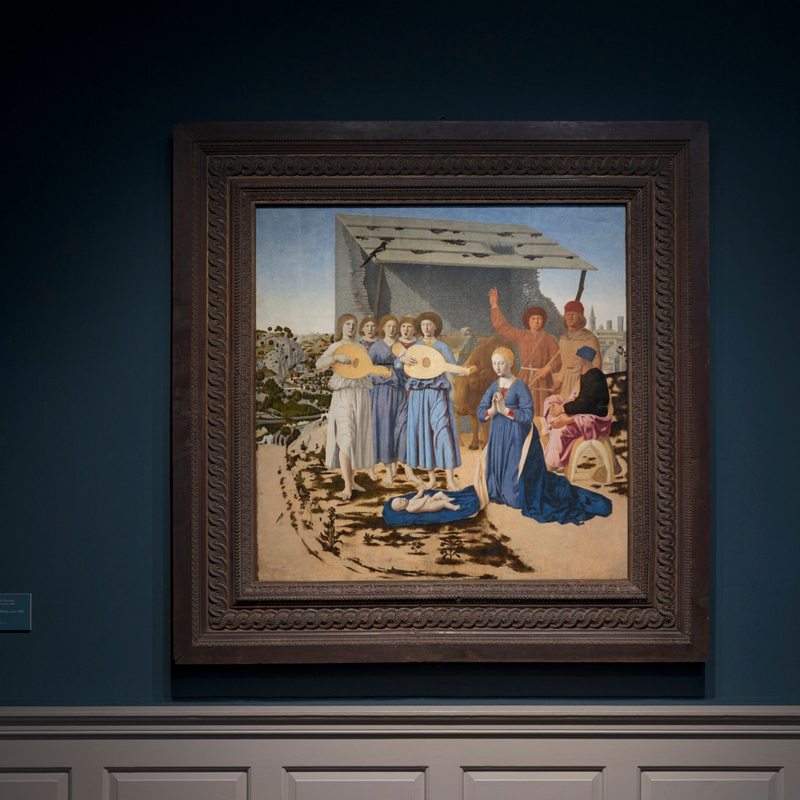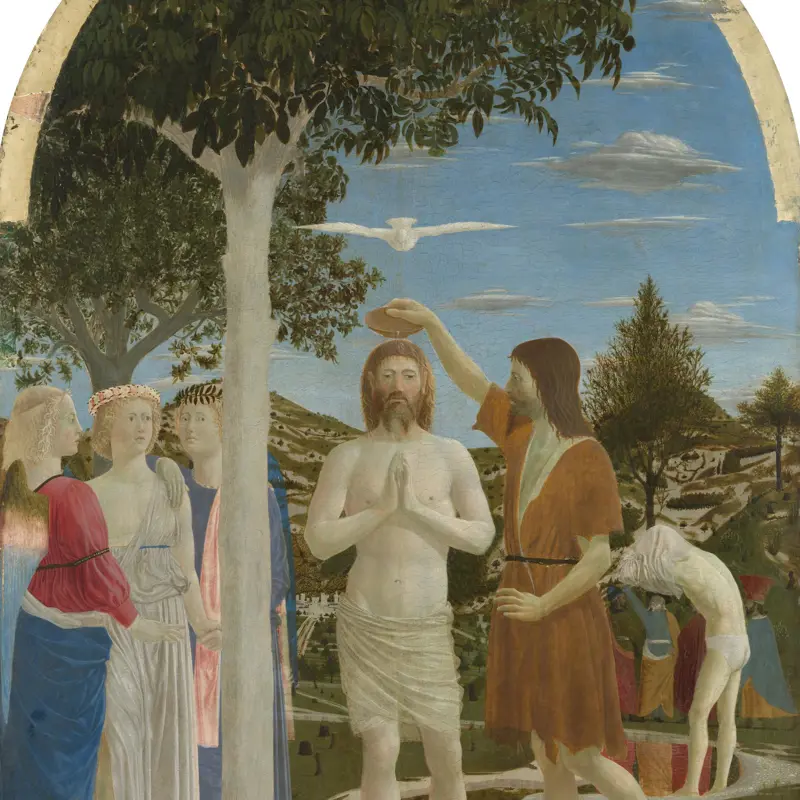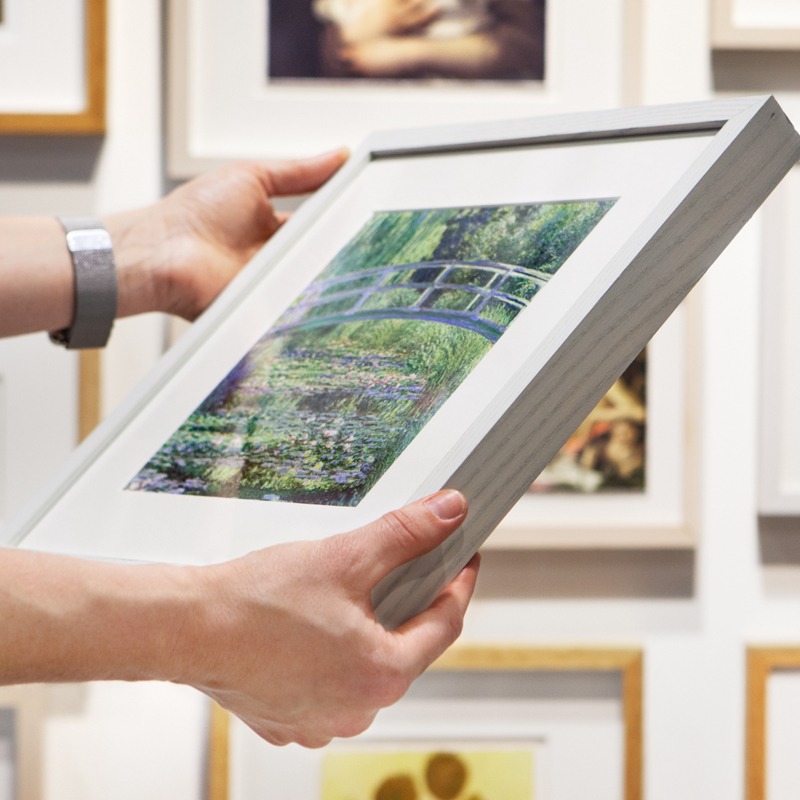Piero della Francesca, 'The Nativity', early 1480s
About the work
Overview
Virgin kneels in adoration of her new-born son before a ramshackle shed, emphasising Christ’s humble birth. She is accompanied by her husband Joseph and two shepherds, one of whom points to the divine light falling on the shed’s stone wall through a hole in its roof. Music-making angels provide a heavenly soundtrack to this otherwise rustic scene.
Piero della Francesca depicted Christ’s Nativity materialising as a mystical vision, basing the details of his composition on a famous account by Saint Bridget of Sweden (about 1303–1373). By setting Saint Bridget’s vision within a familiar Tuscan landscape, the artist brought the extraordinary circumstances of Christ’s birth directly into his own world.
Piero painted The Nativity for his family palace in Borgo San Sepolcro where it remained until 1825, initially hung in the principal bedchamber. While still in the family, parts of the paint surface were badly damaged by overcleaning, causing some to believe that the painting was unfinished. Restoration and conservation treatment, completed in 2022, enhanced its legibility, recovering much of Piero’s original intention.
Key facts
Details
- Full title
- The Nativity
- Artist
- Piero della Francesca
- Artist dates
- about 1415/20 - 1492
- Date made
- early 1480s
- Medium and support
- oil on wood
- Dimensions
- 124.4 × 122.6 cm
- Acquisition credit
- Bought, 1874
- Inventory number
- NG908
- Location
- Room 66
- Collection
- Main Collection
- Previous owners
- Frame
- 15th-century Italian Frame
Provenance
Additional information
Text extracted from the ‘Provenance’ section of the catalogue entry in Martin Davies, ‘National Gallery Catalogues: The Earlier Italian Schools’, London 1986; for further information, see the full catalogue entry.
Bibliography
-
1874J.W.C. Carr, 'The National Gallery', Art Journal, 1874, pp. 257ff
-
1874Christie, Manson & Woods, Catalogue of the Renowned Collection of Works of Art, Formed by that Distinguished Connoisseur, Alexander Barker, Esq., London, 6 June 1874 - 11 June 1874
-
1875S. Colvin, 'Piero della Francesca', Cornhill Magazine, XXXI, 1875, pp. 167-83
-
1895C. Monkhouse, In the National Gallery, London 1895
-
1900W. Weisbach, 'Ein verschollenes Selbstbildnis des Pietro della Francesca', Repertorium für Kunstwissenschaft, XXIII, 1900, pp. 388-91
-
1903J.A. Crowe and G.B. Cavalcaselle, A History of Painting in Italy, Umbria, Florence and Siena, from the Second to the Sixteenth Century, ed. R.L. Douglas, 2nd edn, 6 vols, London 1903
-
1912E.F. Marini, Piero della Francesca 'Monarca della pittura ai suoi dì', Città di Castello 1912
-
1951Davies, Martin, National Gallery Catalogues: The Earlier Italian Schools, London 1951
-
1951K. Clark, Piero della Francesca, London 1951
-
1952H. Focillon, Piero della Francesca, Paris 1952
-
1953G. Robertson, 'The National Gallery Catalogue of Early Italian Schools', The Burlington Magazine, XCV/598, 1953
-
1961M. Davies, The Earlier Italian Schools, 2nd edn, London 1961
-
1963C. Tolnay, 'Conceptions religieuses dans la peinture de Piero della Francesca', Arte antica e moderna, XXIII, 1963, pp. 213-5
-
1967M.A. Lavin, 'The Altar of Corpus Domini in Urbino: Paolo Uccello, Joos van Ghent, Piero della Francesca', Art Bulletin, XLIX/1, 1967, pp. 1-24
-
1968C. Gilbert, Change in Piero della Francesca, New York 1968
-
1968P. Hendy, Piero della Francesca and the Early Renaissance, London 1968
-
1978V.I. Stoichita, 'Deux œuvres ferraraises au Musée d'Art de la République Socialiste de Roumanie I: Qualche fabule antiqua et de bello significato', Revue roumaine d'histoire de l'art, XV, 1978, pp. 19-52
-
1980R. Longhi, Piero della Francesca: 1927 Con aggiunte fino al 1962, Florence 1980
-
1980R. Cocke, 'Piero della Francesca and the Development of Italian Landscape Painting', The Burlington Magazine, CXXII/930, 1980, pp. 627-31
-
1982P. Barolsky, 'Piero's Native Wit', Source, I, 1982, pp. 21-2
-
1983L.C. Vegas, Italie et Flandres dans la peinture du XVe siècle, Milan 1983
-
1986Davies, Martin, National Gallery Catalogues: The Earlier Italian Schools, revised edn, London 1986
-
1989A. Paolucci, Piero della Francesca. Notizie sulla conservazione di Margherita Moriondo Lenzini, Florence 1989
-
1990A. Janhsen, Perspektivregeln und Bildgestaltung bei Piero della Francesca, Munich 1990
-
1990A. Paolucci, Piero della Francesca: Catalogo completo dei dipinti, Florence 1990
-
1991B. Cole, Piero della Francesca: Tradition and Innovation in Renaissance Art, New York 1991
-
1991J. Dunkerton et al., Giotto to Dürer: Early Renaissance Painting in the National Gallery, New Haven 1991
-
1991C. Bertelli, 'Una candela per Piero della Francesca', Paragone, XLII, 1991, pp. 62-9
-
1992E. Battisti, Piero della Francesca, Milan 1992
-
1992C. Bertelli, Piero della Francesca, New Haven 1992
-
1992R. Lightbown, Piero della Francesca, New York 1992
-
1992C. Maltese, 'Piero della Francesca e l'applicazione delle proiezioni parallele alla pittura', in V. Carmi and P. Semoli (eds), Studi di storia dell'arte medioevo e il Rinascimento nel centenario della nascita di Mario Salmi: Atti del convegno internazionale, Arezzo-Firenze, 16-19 novembre 1989, Florence 1992, pp. 489-517
-
1993R. White and J. Pilc, 'Analyses of Paint Media', National Gallery Technical Bulletin, XIV, 1993, pp. 86-94
-
1994L. Cheles, 'Piero della Francesca in Nineteenth-Century Britain', The Italianist, XIV, 1994, pp. 231-8
-
1995J.V. Field, 'A Mathematician's Art', Studies in the History of Art, XLVIII, 1995, pp. 176-97
-
1995M.A. Lavin, 'Piero's Meditation on the Nativity', Studies in the History of Art, XLVIII, 1995, pp. 126-41
-
1995B.W. Meijer, 'Piero and the North', Studies in the History of Art, XLVIII, 1995, pp. 142-59
-
1995E. Morris and C. Fifield, 'A. G. Kurz: A Patron of Classical Art and Music in Victorian Liverpool', Journal of the History of Collections, VII/1, 1995, pp. 103-14
-
1996L. Cheles, 'Piero della Francesca e i Vittoriani', in M. Dalai Emiliani and V. Curzis (eds), Piero della Francesca tra arte e scienza: Atti del Convegno Internazionale di Studi, Arezzo, Sansepolchro, 1992, Venice 1996, pp. 569-92
-
1997P. Reuterswärd, 'Tysta bilder och ljudande', Konsthistorisk Tidskrift, LXVI/4, 1997, pp. 183-95
-
2001
C. Baker and T. Henry, The National Gallery: Complete Illustrated Catalogue, London 2001
-
2002M.A. Lavin (ed.), Piero della Francesca, London 2002
-
2003M. Carminati, Piero della Francesca, Milan 2003
-
2005J.V. Field, Piero Della Francesca: A Mathematician's Art, New Haven 2005
-
2008G. Forgione, 'La "follia" ferrarese e la "ragione" di Piero: I due Rinascimenti', Storia dell'arte, XIX, 2008, pp. 53-68
About this record
If you know more about this work or have spotted an error, please contact us. Please note that exhibition histories are listed from 2009 onwards. Bibliographies may not be complete; more comprehensive information is available in the National Gallery Library.




